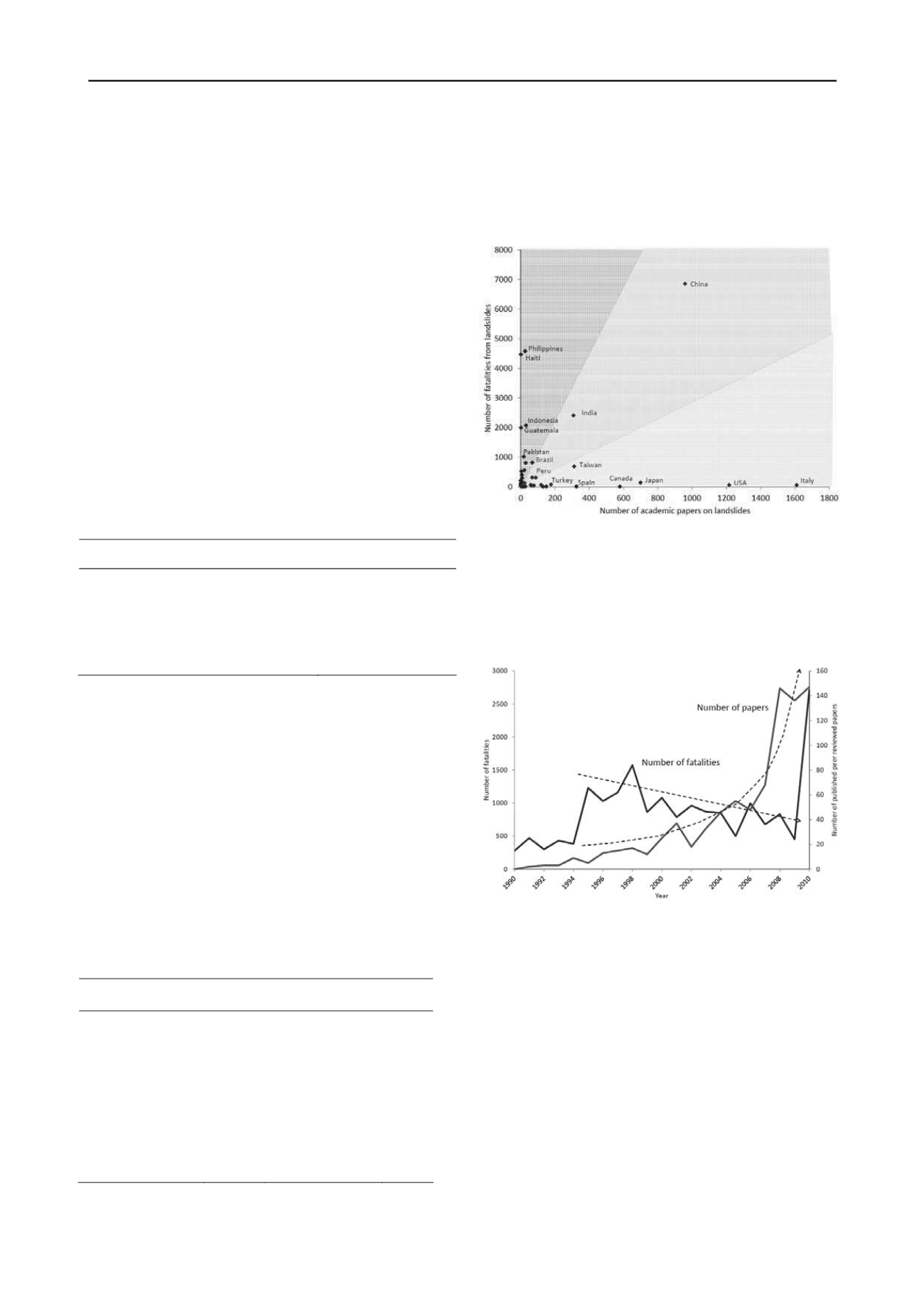
2138
Proceedings of the 18
th
International Conference on Soil Mechanics and Geotechnical Engineering, Paris 2013
slides, with multi-hazard landslides (mostly earthquake coupled
with debris flow) accounting for 10%. The remaining papers
address progressive slides (4%) or the triggering / landslide type
is unspecified (19%).
The fact that there are 10 papers on debris flows or flow
slides is a marked increase on previous years. For the 16
th
International Conference on Soil Mechanics and Geotechnical
Engineering, Chau (2005) noted that only two papers dealt with
debris flows. While as Chau (2005) has pointed out, there are
dedicated conferences on debris flows elsewhere, the inclusion
of these papers in a broader geotechnical forum is promising in
terms of applying geotechnical rigor to a problematic subject of
global concern.
The recognition of landslides within a multi-hazard causal
framework is also extremely important, although the number of
papers presented is still relatively small. As determined by Lin
et al. (2004), amongst others, earthquakes can lead to worsening
conditions for landslides and debris flows, while landslides can
be the precursor of debris flows particularly where the landslide
meets a body of water or ice. A thorough understanding of the
complexity of such scenarios is believed warranted, because the
state-of-the-art must continue to inform the state-of-practice
and, on occasion, the cutting-edge of practice is challenged to
address some very challenging realities of risk management.
Table 2. Number of papers by instability type
Type of failure
Papers
Rainfall / pore pressure induced
11 (14)
Earthquake induced
3 (7)
Debris flow / flow slide
10 (11)
Multi-hazard
4
Progressive
2
Unspecified
7
(Parentheses indicate numbers that include multi-hazard papers)
1.3
Breakdown of research papers by country
Table 3 presents the number of papers from different
countries and indicates an important reality with respect to
where research activity is currently concentrated by region. As
has been previously noted by Petley (2012), much of the work
on landslides is carried out by researchers in developed
economies, where the focus has moved from life impacts (which
have been reduced over time due to the development of a
relatively good understanding of catastrophic landslide behavior
in these countries) to economic impacts (which may be more
influenced by slower movements and low-magnitude, albeit
high- frequency events). However, in emerging and developing
economies, which have large numbers of landslides per annum,
there is relatively little research on-going, the threat to life
remains unacceptably large.
Table 1. Number of papers in session by country / province
Country
Papers
Country
Papers
Norway
6
India
1
Japan
4
Korea
1
Taiwan / Chinese
Taipei
4
Lebanon
1
USA
4
New Zealand
1
3
Hong Kong, China
3
Russia
1
Albania
2
Sweden
1
Brazil
1
Turkey
1
Canada
1
United Kingdom
1
Mainland China
1
Vietnam
1
Greece
1
To illustrate this, Figure 1 after Petley (2012) presents the
total number of publications on landslides found in ISI journals
for each country (taken from provenence of the lead author’s
institution) against the recorded number of fatalities in those
countries in the period from 2004 to 2010. He has divided the
figure into three zones – termed research intensive, research
active, and research inactive. The results clearly show that many
countries which are least research active have some of the
highest incidences of landslide fatalities.
Figure 1. Total number of publications on landslides / slope stability by
country in ISI journals from 2006-2010, reproduced from Petley (2012).
Using China as an example, Petley (2012) also showed that
increasing the research intensity within a country prone to
landslide activity can reduce the rate of fatalities experienced.
Two decades of data from 1990 to 2013 are reproduced in
Figure 2.
Figure 2. Example of the effect of increasing annual research on
landslides on the rate of fatalities in China over 20 years, after Petley
(2012). Note that a single landslide that occurred in 2010 in Gansu
province killed over 1700 people, which distorts the overall dataset.
In the following section, papers are grouped by type of
instability (Table 2).
2 RAINFALL / PORE PRESSURE INDUCED SLOPE
INSTABILITY
This section discusses the major findings of the 11 papers on
rainfall or elevated pore pressure induced landslides.
Two papers by
Wang et al.
and
Uchimura et al.
discuss the
use of a tilt-sensor to detect the onset of instability in slopes that
are experiencing creep movements.
Wang et al.
covers details of
innovative sensor development and field installation.
Uchimura
et al
. elaborates further on the use of the device coupled with
volumetric water sensors within an experimental arrangement of
artificial rainfall on natural ground. The experiments show that
instability can be detected by an increase in the rate of change
of the tilt angle, while the volumetric water content is related to


